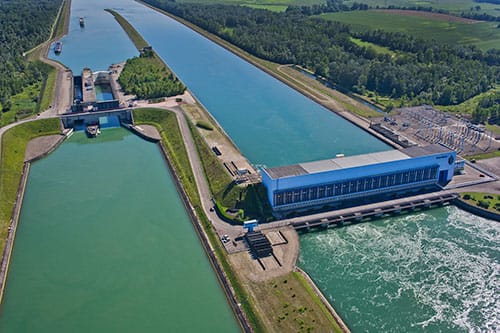

June 25, 2025
8
Min reading

With 69.8 TWh in 2024, renewable hydroelectricity reached its record level of production since 2013. Second source of electricity in France, it is also the first source of renewable energy.
At the end of 2024, theHydraulic power represented 14% of national electricity production, far behind nuclear power with 67.4%, but ahead of other renewable energies (wind, solar, bioenergies, etc.). In 2024, its production covered 15.8% of French electricity consumption.
Derived from the power of water, hydraulic power is a renewable energy with low greenhouse gas emissions and reduced production costs. These advantages seem to make it an indispensable energy to achieve the carbon neutrality in 2050.
However, despite the record increase in production in 2024, the last few years have shown the limits of the potential of “white coal”.
Is it energy from the future or from the past? What are its strengths and challenges? How can it be part of the energy transition?
Lighting.
Run-of-river power plant, lake power plant, small hydroelectric power plant, STEP (pumped energy transfer station)...: these different types of hydroelectric installations are distinguished by Their power and their production potential.
But they all share one thing in common: use the force of water to produce electrical energy.

Source: Run-of-river power plant - Encyclopedia of Energy
Hydraulic power uses thekinetic energy created by the movements of water to produce energy. It operates natural movements like currents or waterfalls, or artificial elevations created by man. The greater the height difference between the downstream and the upstream of the power plant, the higher the water pressure and the more the production capacity increases.
Unlike wind and solar, hydroelectricity offers energy storage capacities can be immediately transformed into electricity without loss of efficiency. It thus plays a major role in the regulation of electricity production and distribution.
The hydraulic power system is based on turbines. These are activated by the movements of the water. The greater the pressure and the speed of the water, the faster the hydraulic turbines rotate.
Kinetic energy is transformed into so-called mechanical energy. It can be used directly, as in the case of the watermills of our ancestors, or transformed into electrical energy.
It is the alternator or generator that transforms mechanical energy in electrical energy. The electric current then passes through a transformer to adapt the voltage to domestic uses and allow the transport of electricity in the network.
Some hydroelectric power plants are equipped with a weir.
Its role: to retain water. This is released on demand via a system of valves, and directed to the turbines via pipes.
Powerful installations with strong differences in altitude, lake power plants make it possible to quickly regulate electricity production according to consumption needs.
Conversely, run-of-river power plants and small hydropower plants do not have storage tanks. Water flows naturally for continuous electricity production.
A renewable and clean energy, hydraulic electricity has numerous environmental advantages. Produced locally, it contributes to the economic development of territories.
Hydraulic power emits very few greenhouse gases, a considerable advantage for carbon neutrality. Its emissions are estimated at 6 g of CO2 per kWh, identical to those ofnuclear electricity.
To compare with other renewable energies, photovoltaic electricity emits an average of 44 g eq. CO2/kWh and onshore wind 14 g eq. CO2/kWh. These greenhouse gas emissions are much lower than those of fossil fuels: 243 g eq. CO2/kWh for natural gas or 1,060 g eq. CO2/kWh for a coal power plant.
Water is also a natural and sustainable resource. During the hydraulic power production cycle, it does not undergo any transformation. It follows its path and reintegrates the water life cycle downstream.
What if your electricity really reflected your commitments?
Opt for renewable, local and competitive energy, while keeping your costs under control.
Let's talk about your energy needs
As the Commission de Régulation de l'Énergie (CRE) observes, the cost of hydroelectric production varies greatly from one installation to another. It varies from 37 to more than 200 €/MWh depending on investment and operating costs, the capacity of the structure and its age. In comparison, in a 2023 report, CRE estimated the full cost of nuclear power at €60.7/MWh over the period 2026-2030.
But while the most powerful power plants may require large investments, operating and maintenance costs are reduced. And these very long-lasting installations allow certain amortization of costs over time.
Very localized, the hydroelectric sector contributes to the economic development of territories. According to a study by the Syndicat des Énergies Renouvelables, hydroelectricity represents more than 30,000 direct, indirect and induced jobs in France, which cannot be relocated.
Large dams are also attractive tourist sites, rooted in local history. Hiking, industrial tourism, sports activities can be organized safely around the reservoirs, in partnership with operators.
No power generation solution is perfect. While hydraulic power offers many advantages, it raises environmental and safety questions.
The construction of hydroelectric dams and their artificial water reservoirs is shaking up the surrounding ecosystems.
As early as 2006, France took up this issue in order to reduce the environmental impact of hydroelectricity. The law on water and aquatic environments imposes a framework for the deployment of hydroelectric power plants.
It requires operators to take measures to preserve the fauna and flora upstream and downstream of the power plants: maintain watercourses at a reserved minimum flow, set up fish passes, respect stream beds, etc. The legislation also protects certain watercourses, etc. The legislation also protects certain watercourses, which are identified as natural reserves for certain aquatic species.
In 1959, the collapse of the Malpasset dam in Fréjus, Var, caused the death of 423 people. This accident is the only one recorded in France over a century.
While dam failures are rare, France has put in place a reinforced security system. Under the aegis of the State Hydraulic Works Safety Control Service (SCSOH), operators are required to constantly monitor hydroelectric power plants and to carry out regular checks and periodic hazard studies.
A pioneer energy, hydroelectricity is one of the oldest energies in the world. If it had its heyday in the 20thE century, can it find its place in the 21stE century?
France has more than 2,500 hydroelectric installations. With 25.7 GW installed, the power potential has remained stable for several years. The greatest potential for hydraulic production is located in the mountainous regions of the South.
In 2024, the podium is occupied by:
The second largest producer of hydroelectricity in Europe after Norway, France remains far from the main producers of hydroelectricity in the world: China, Brazil, Canada and the United States.
Globally, hydroelectricity represented 14.3% of global electricity production in 2024. It is the third source of electricity behind the coal (34.3%) and the natural gas (22%).
The Three Gorges Dam in China is the largest hydroelectric power plant in the world. With 22.5 GW installed, it represents the power of 16 nuclear reactors.
With 25.7 GW of installed capacity, hydroelectricity represents 17.4% of the French electrical production and storage fleet, but only 14% of the electricity produced.
While 2024 was a record production year due to abundant rainfall, hydropower suffered several years of drought, especially between 2020 and 2022, with a drop in production of 28%. Hydroelectricity is therefore highly dependent on hydrological conditions.
Second limit to the development of hydraulic energy in France: the achievement of the production capacities of the French hydroelectric park, deployed since the end of the 19th centuryE century.
However, there is still room for improvement. The project of multiannual energy programming under discussion (PPE3) plans to increase the capacity of hydroelectric power plants by 2.8 GW in 2035. France is focusing in particular on WWTPs, with 1.7 GW of additional power.
Globally, hydroelectric potential is far from reaching its peak. According to Pierre-Louis Viollet, director of the EDF R&D department, annual production now reaches a third of its capacity.
The African, South American and Asian continents contain unexploited resources. Investments coupled with strong political will could increase global hydroelectric production to 14,600 TWh and cover 75% of global electricity consumption.
Among the flagship hydroelectric projects, China announced in early 2025 the construction of the world's largest dam: with a capacity of 60 GW, the Motuo dam should produce around 300 TWh each year, almost the equivalent of France's annual nuclear production!
Other gigantic dams are under construction or studies, including the Australian “Snowy” 2.0 project.
Following construction delays, the commissioning of this 2,000 MW wastewater treatment plant with a capacity of 350 GWh and a storage capacity of 350 GWh is expected in 2028.
To conclude...
Renewable, economical and low CO emitting2, hydraulic power is emerging as an essential energy source in the energy transition. It forms the basis of tomorrow's energy mix, alongside solar and wind energy.
Although its development prospects seem limited in France, existing hydroelectric power plants constitute a real energy treasure to be preserved and optimized in order to continue to transform blue gold into electricity. What if the future of hydropower also came from small hydroelectricity and from the sea with tidal energy.

.png)

Sourcing consists in identifying and analysing the offers of several electricity and gas suppliers. This approach makes it possible to obtain contracts adapted to the consumption profile and budgetary constraints of the company.
.png)

Tertiary companies must manage their energy costs while guaranteeing the comfort of users (offices, shops, services). Consumption is often linked to heating, air conditioning and lighting, which requires precise monitoring to avoid budgetary excesses.
.png)

Tertiary companies are concerned by taxes such as TICFE or TICGN. Sirenergies checks the accuracy of invoices, identifies possible exemptions, and helps correct errors to sustainably reduce costs.
.png)

Some businesses may obtain a partial or total exemption from the TICFE or the TICGN, depending on their activity and energy intensity. The support of an expert makes it possible to identify the eligibility criteria and to put together the file.
.png)

The industry is concerned by TICFE, TICGN and other contributions that may represent an important part of invoices. Sirenergies identifies cases of exemption and accompanies the procedures to benefit from them.
.png)

One invoice consists of several elements: consumption, supplier share, taxes and contributions. The analysis of each line makes it possible to identify possible errors and to check the consistency with the signed contract.
.png)

Farms are subject to taxes such as TICFE or TICGN. Sirenergies verifies their application, identifies cases of exemption and accompanies the procedures to reduce the tax burden.
.png)

Un appel d’offres permet de mettre en concurrence plusieurs fournisseurs d’électricité et de gaz afin d’obtenir des conditions contractuelles optimisées. C’est une démarche transparente qui permet de choisir l’offre la plus adaptée aux besoins budgétaires et techniques de l’organisation.

